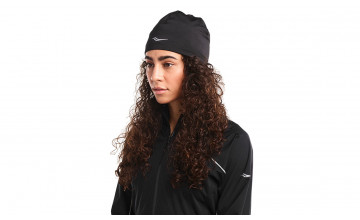Five Training Tips for Better Winter Running
Winter is really kicking it to Canadians this year, but that doesn’t have to slow down your training. Here are five ways you can out run winter without winter running you!
GET OUT AND STAY OUT!
Cold temperatures and shorter days should be no excuse for discontinuing your outdoor running or walking program. The onset of winter weather doesn’t necessarily mean your only option is to spend hours in a musty basement on a treadmill staring at a wall.
You can (and should) maintain an outdoor running or walking program year round. Running or walking through the winter will keep you fit and help you avoid post-holiday and early new year weight gain. (Very few people will keep a New Year’s resolution when starting a program in the dead of winter. It’s much easier to maintain rather than to start from scratch.)
Winter running will not only give you big head start when springs comes and you’re preparing for that target race, you’ll also be fit and ready to race an event during January, February, or March. And it’s good to know that most runners and walkers who continue their outdoor workouts through the winter months experience less seasonal depression as well as suffer fewer early season injuries than their sedentary counterparts.
SEE AND BE SEEN
Try to take advantage of daylight hours for both light and warmth. Plan ahead for your run or walk by laying out your clothing ahead of time so it’s ready for you as soon as you get home. Or pack it along with you for a lunch break or mid-day workout.
If you must walk or run in the dark, your goal is to see and be seen. To help you see those potentially slippery spots, carry a small flashlight with a wrist strap or wear a small headlamp which will allow you to keep your hands free.
Wear clothing with plenty of reflectivity – not just light colors, but also reflective material like that made by 3M® or Illuminite®. Add a hi-visibility vest with reflective strips and consider small clip-on battery-powered blinking lights which are almost weightless but can be seen from hundreds of meters away.
DRESS FOR SUCCESS
The biggest complaint most people have with running or walking outdoors in the winter is the cold. But, you don’t have to be intimidated by low temperatures if you follow a few simple rules.
You need to dress correctly…and that means no cotton – anywhere – including your socks. You should also avoid sweatshirts and sweatpants because they get wet and stay wet. Wear a base layer made from synthetic fabric. Tightly woven synthetics are lightweight, they wick moisture, retain warmth when wet, dry quickly – and look great. Include an insulative layer if it’s really cold.
If your feet get cold, wear a pair of thin sock liners under your regular running socks. Buying a pair of running shoes for winter a half size larger will allow for an additional layer. Several manufactures are now offering completely waterproof Gore-Tex® lined running shoes.
Remember, mittens are warmer than gloves. For extreme cold, wear nylon mitten shells with synthetic glove liners. Include a cap or headband to retain heat and prevent heat loss from the head.
Dress for approximately 5-6 degrees warmer than the actual temperature. If you’re warm and toasty when you first step out, you’re overdressed. You’ll probably get too warm, and be damp and cold by the time you get back.
AGAINST THE WIND
One of the simplest things you can do to feel more comfortable during your winter run or walk is to face the wind when you first head out – when you’re warm and dry. That way, the wind will be at your back for the return trip – when you’re tired and possibly getting cold or even wet. Generally, prevailing winds come from the west. So for most winter runs or walks you should start out heading west and return facing the east.
If the wind causes your eyes to water excessively, wear wrap-around style sunglasses which will reduce airflow to your eyes. Some sunglasses (like those for motorcyclists) come with a soft gasket that blocks the wind. In more extreme conditions – like blowing snow, try wearing a pair of ski googles.
The tip of your nose, your lips, and the tender skin around the eyes are especially vulnerable to frostbite. So protect exposed skin from frostbite and windburn with a thin layer of petroleum jelly or a specialized frost-proof cream.
CAUTION: ICE!
A major hazard for runners and walkers during the winter is ice. If ice is a concern and causes you to avoid running or walking outdoors, consider purchasing lightweight slip-on tread straps for better traction.
Or try this trick…purchase tiny hex screws – like those found on the back of appliances – from a hardware store and screw them in along the perimeter on soles of your running or walking shoes. Be sure the screw portion is no longer than 3/8″. And never insert a screw directly under the foot. The screws must only be on the outer edge of the sole (where the bottoms of your feet don’t make contact with the edges of the shoes). Insert 10 – 14 screws total for each shoe. (They can be easily removed when the ice is gone.)
These hex screws will act as tiny cleats and will provide excellent traction on ice and hard-packed snow. You’ll be able to run or walk normally with complete confidence and continue training regardless of the weather. Just be sure to take off your shoes before walking on your new carpeting or hardwood floors!
With the right gear and a little preparation, you will be able maintain your outdoor training all winter long and be ready to toe the line for late winter events the Chilly Half Marathon or Frosty 5K.
Mark Sullivan is a coach who has written numerous articles on the sport of running and has been featured in various media outlets. Sullivan has completed over 175 marathons with an average time under 3 hours, and 31 consecutive Boston Marathons.


















 Our Magazine
Our Magazine
